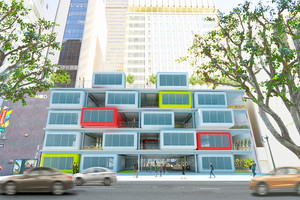
As soon as 2030, the trend toward fewer and smaller cars will mean a reduced need for wide roads and parking, reshaping cities and how people interact. At least that is how Ross Conway, design director and principal at Gensler, an architecture firm, conceives the future. Conway was one of several speakers at a recent parking symposium in Arlington, Texas, sponsored by several groups, including ULI North Texas.

Conway said that Gensler has been doing research with a couple of think tanks about the future of cars. He flashed concepts onto a screen about what future driverless cars might look like. They included ones that looked like an office, a living room, or a bedroom inside. Surveys asked people what they would do inside of cars if they didn’t need to drive them. The answers included sleeping, working, and reading.
Compact driverless electric cars, once they become mainstream, will usher in many changes in U.S. urban centers from how cities are designed to how real estate is developed, he said. Curbside parking may disappear. Parking spaces will be narrower. Office buildings may need a large “queuing” area at the front where autonomous cars drop their passengers. Parking garages and parking lots will be converted to other uses.
About 25 to 35 percent of U.S. cities consist of streets. U.S. cities contain 500 million parking spaces—roughly 3,590 square miles (333 sq km)—an area larger than Delaware and Rhode Island combined.
Conway said that Gensler is working with several clients to restrategize the design of parking garages so that they can be converted to other uses in the future. “Above-grade parking is more likely to transition to another use than below-ground parking,” Conway said. Gensler recommends flat-surfaced floors with higher ceilings. A parking garage designed this way could be converted to office space, apartments or a fitness center. A below- ground garage designed this way could house a data center. Park-on ramps are diminishing in number, he said.
Developers may want to consider more rigid parking structures as well, to avoid vibrations. They may also want to consider wider driving lanes at building entrances to better accommodate pick-ups/drop-offs and queuing of driverless cars. “We are, in some cases, enclosing garages, but I don’t think that’s a necessity in the garages’ being able to be transformed,” Conway said. The future could also involve more robotic lifts to park cars.
He showed the audience a conceptual redevelopment of a parking garage that had living and working “pods.” The automated car could be part of a person’s house in the reimagined parking garage. It would be pulled into the garage, and the owner would open up the side of the car, which would house the living room. The developer would add a kitchen and a bathroom for the “ultimate micro unit,” Conway said.
Amid all the talk of change are developers’ concerns about potential parking revenue losses. “Our West Coast clients rely heavily on charging people for parking,” Conway said. “There will be charging for parking of autonomous cars. You could pay extra to have your car park itself really close to the restaurant you are in.” But Conway said that he expects parking revenues to diminish as autonomous cars become mainstream.
If parking doesn’t need to occur where the person was dropped off, then there could be options for more green-space amenities around offices, retail, and restaurants in the future. Bike lanes and sidewalks could be added to improve the pedestrian experience. “I think you will see a lot more green-space requirements by municipalities as parking requirements reduce or parking gets moved to a remote area,” he said. A number of cities worldwide already have networks of car-free streets with plenty of green space. These pedestrian cities include Copenhagen, Florence, New York, Marrakech, Paris, Vancouver, Buenos Aires, Dubrovnik, Melbourne, and Boston.
“There are a thousand scenarios out there,” he said. “It’s important to understand your world is changing. Whether you want it to or not. It will be here before I’m gone and most of you will be comfortable with it before you are gone. “Adoption is a big question,” Conway admits, but said he expects major changes within 20 years. “The technology is going to happen.” Conway said that he plans to be an early adopter. “It’s my plan that my next car,” he said, “is going to be an autonomous vehicle of some sort.”
Quelle: UrbanLand
